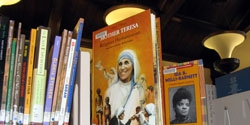 Assessing Projects : Using Assessment to Improve Teaching and Learning
Assessing Projects : Using Assessment to Improve Teaching and Learning Intermediate Phase Assessment Plans | Senior / FET Phase Assessment Plans

Biographies
At a Glance
|
Grade Level: 3-5
Subjects: Language Topics: Biographies Higher-Order Thinking Skills:Metacognition, Making Connections Key Learnings: Interviewing, Narrative Writing, Biographies Time Needed: 40 minutes a day for 2 weeks |
Things You Need
Assessing Projects (CD)
Assessing Projects* (online)
|
Project Summary After listening to and reading several biographies, both in books and magazines, learners brainstorm about what makes a biography interesting and what makes a person important to answer the Essential Question, How are we all unique? They then interview the residents of a local nursing home to find out what makes the person unique and write articles about them. After learners receive feedback from their peers and participate in learner-led conferences with the teacher about their writing, they work in a group to compile the articles into a magazine. In a final celebration, the learners share their publication with the senior citizens who they interviewed. Curriculum-Aligned Questions
This timeline shows in chronological order the different types of formal and informal assessments that occur during the unit. The table below explains how each assessment is used and who uses it for what purpose.
Credits A teacher contributed this idea for a classroom project in the USA. A team of educators expanded the plan into the example you see here. |
